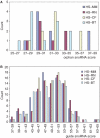snoSeeker: an advanced computational package for screening of guide and orphan snoRNA genes in the human genome
- PMID: 16990247
- PMCID: PMC1636440
- DOI: 10.1093/nar/gkl672
snoSeeker: an advanced computational package for screening of guide and orphan snoRNA genes in the human genome
Abstract
Small nucleolar RNAs (snoRNAs) represent an abundant group of non-coding RNAs in eukaryotes. They can be divided into guide and orphan snoRNAs according to the presence or absence of antisense sequence to rRNAs or snRNAs. Current snoRNA-searching programs, which are essentially based on sequence complementarity to rRNAs or snRNAs, exist only for the screening of guide snoRNAs. In this study, we have developed an advanced computational package, snoSeeker, which includes CDseeker and ACAseeker programs, for the highly efficient and specific screening of both guide and orphan snoRNA genes in mammalian genomes. By using these programs, we have systematically scanned four human-mammal whole-genome alignment (WGA) sequences and identified 54 novel candidates including 26 orphan candidates as well as 266 known snoRNA genes. Eighteen novel snoRNAs were further experimentally confirmed with four snoRNAs exhibiting a tissue-specific or restricted expression pattern. The results of this study provide the most comprehensive listing of two families of snoRNA genes in the human genome till date.
Figures





References
-
- Kiss T. Small nucleolar RNAs: an abundant group of noncoding RNAs with diverse cellular functions. Cell. 2002;109:145–148. - PubMed
-
- Balakin A.G., Smith L., Fournier M.J. The RNA world of the nucleolus: two major families of small nucleolar RNAs defined by different box elements with related functions. Cell. 1996;86:823–834. - PubMed
-
- Bachellerie J.P., Cavaille J., Huttenhofer A. The expanding snoRNA world. Biochimie. 2002;84:775–790. - PubMed

